IBM提交建设云计算环境的参考架构CCRA.IBMSubmission.02282011
- 格式:doc
- 大小:2.01 MB
- 文档页数:36
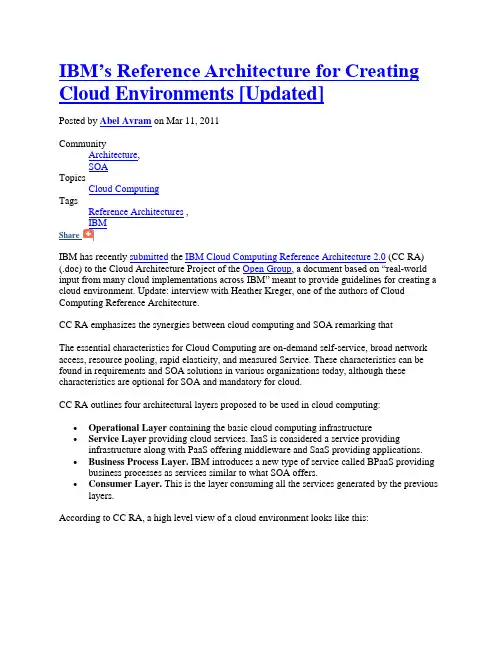
IBM’s Reference Architecture for Creating Cloud Environments [Updated]Posted by Abel Avram on Mar 11, 2011CommunityArchitecture,SOATopicsCloud ComputingTagsReference Architectures ,IBMShare |IBM has recently submitted the IBM Cloud Computing Reference Architecture 2.0 (CC RA) (.doc) to the Cloud Architecture Project of the Open Group, a document based on “real-world input from many cloud implementations across IBM” meant to provide guidelines for creating a cloud environment. Update: interview with Heather Kreger, one of the authors of Cloud Computing Reference Architecture.CC RA emphasizes the synergies between cloud computing and SOA remarking thatThe essential characteristics for Cloud Computing are on-demand self-service, broad network access, resource pooling, rapid elasticity, and measured Service. These characteristics can be found in requirements and SOA solutions in various organizations today, although these characteristics are optional for SOA and mandatory for cloud.CC RA outlines four architectural layers proposed to be used in cloud computing: ∙Operational Layer containing the basic cloud computing infrastructure∙Service Layer providing cloud services. IaaS is considered a service providing infrastructure along with PaaS offering middleware and SaaS providing applications.∙Business Process Layer. IBM introduces a new type of service called BPaaS providing business processes as services similar to what SOA offers.∙Consumer Layer. This is the layer consuming all the services generated by the previous layers.According to CC RA, a high level view of a cloud environment looks like this:CC RA continues by detailing each section of the diagram including the Common Cloud Management Platform (CCMP) which contains the largest number of components:The CC RA is built on the ELEG ( Efficiency, Lightweightness, Economies-of-scale, Genericity) principles:1.Design for Cloud-scale Efficiencies: When realizing cloud characteristics suchas elasticity, self-service access, and flexible sourcing, the cloud design is strictlyoriented to high cloud scale efficiencies and short time-to-delivery/time-to-change.(“Efficiency Principle”)2.Support Lean Service Management: The Common Cloud Management Platformfosters lean and lightweight service management policies, processes, andtechnologies. (“Lightweightness Principle”)3.Identify and Leverage Commonalities: All commonalities are identified andleveraged in cloud service design.(“Economies-of-scale principle”)4.Define and Manage generically along the Lifecycle of Cloud Services: Begeneric acr oss I/P/S/BPaaS & provide …exploitation‟ mechanism to supportvarious cloud services using a shared, common management platform(“Genericity”).Update. Following is a short interview with Heather Kreger, one of the authors of Cloud Computing Reference Architecture.InfoQ: Why did you make this reference architecture public? What do you hope to achieve? And why Open Group?HK: Based on the experience IBM has in the design and deployment of cloud solutions, we wanted to offer the harvested architectural best practices we have accrued in the form of a reference architecture to the Open Group. This can serve as input for standardization process going on in the Cloud Architecture work group. We chose The Open Group because we really see the Open Group as having a center of gravity in architecture standards. They have TOGAF, which has been successful, and that attracts a lot of high quality architects to the standards work there. In combination with the other cloud standards being developed there, The Open Grouphas the right people, momentum and expertise to develop and continue care and feeding of a reference architecture like the CCRA.InfoQ: IBM has endorsed the OpenCloud Manifesto. What is your position regarding OpenStack, considering they are trying to create a cloud computing reference implementation?HK: We understood that OpenStack was creating an implementation but doesn't seem connected to existing standards work. We'd love for them to come participate in the Open Group Cloud Architecture development work.InfoQ: Are you using the Reference Architecture internally at IBM?HK: Yes, the CC RA is used within IBM for multiple purposes, first, as the blueprint for cloud implementations our field practitioners architect, design & implement for customers. This is actually the second version in IBM, we've updated it based on our extensive experience with SOA and Cloud implementations in the industry.Second, we are also using it with our IBM-hosted clouds that we use for internally as well as the ones we offer externally to customers. We've learned a lot and will continue to iterate with our experience with The Open Group. We think this "closed loop" is very important given the quickly evolving cloud space.InfoQ: Are there companies using your Reference Architecture for building cloud infrastructure? HK: Yes, those we've been doing services engagements with, and those who are using our IBM hosted cloud services.InfoQ: Are there companies using the RA to create and consume services in IBM's cloud computing environment?HK: We are working with many clients across various industries where the CCRA proved it's practical relevance and value". Yes, our hosted cloud is based on the CCRA and the CCRA can help those looking to take advantage of those.RelatedVendorContentTaking Control of the Cloud: Addressing Security, Visibility, and GovernanceSpeed SOA development and time to value with IBM WebSphere Enterprise Service Bus Registry EditionOwn your process, own your information, own your business with SOAPrinciples of requirements-driven testingAvoiding the Top 10 Most Devastating Requirements Traps in Software Development Related Sponsor*Security Gateway Buyer's Guide*Gunnar Peterson Tech Tutorials*Visit *Intel's Security Resource for Architects2 commentsWatch Thread ReplyLight on examples? by Robert Sullivan Posted Mar 10, 2011 11:42 AMRe: Light on examples? by Abel Avram Posted Mar 11, 2011 7:39 AMSort by date descending1.Back to topLight on examples?Mar 10, 2011 11:42 AM by Robert SullivanThis is quite detailed, however it seemed to be a little light on the examples. There were a few, but if this is based on "real-world input", then you would think there would be some good case studies and examples of that nature. Granted, I understand that IBM's clientsmay not want to be referenced in the article, so that is understandable.Reply2.Back to topRe: Light on examples?Mar 11, 2011 7:39 AM by Abel AvramI have talked to Heather Kreger, one of the CC RA authors, and he said it is all based onreal-life examples, and he wanted to clarify with their clients who wanted to make it public and who didn't. Unfortunately, Kreger replied too late, after this news waspublished.。
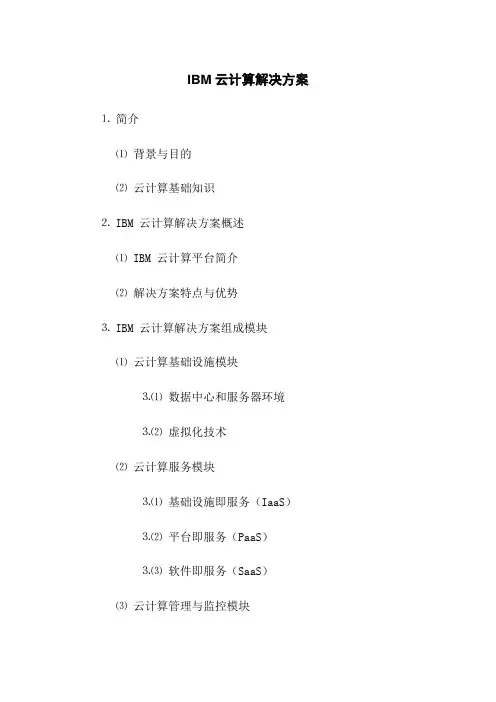
IBM云计算解决方案⒈简介⑴背景与目的⑵云计算基础知识⒉ IBM 云计算解决方案概述⑴ IBM 云计算平台简介⑵解决方案特点与优势⒊ IBM 云计算解决方案组成模块⑴云计算基础设施模块⒊⑴数据中心和服务器环境⒊⑵虚拟化技术⑵云计算服务模块⒊⑴基础设施即服务(IaaS)⒊⑵平台即服务(PaaS)⒊⑶软件即服务(SaaS)⑶云计算管理与监控模块⒊⑴自动化管理工具⒊⑵资源监控工具⒋ IBM 云计算解决方案的应用场景⑴企业信息化⑵应用开发与测试环境⑶大数据分析与⑷科研与教育领域⑸金融与保险行业⒌实施与部署⑴环境准备⑵解决方案组件部署步骤⑶部署验证与测试⒍运维与维护⑴常见问题解答⑵性能优化与扩展⑶安全与风险管理⒎附件⑴详细的架构图⑵平台配置文件法律名词及注释:⒈云计算:云计算是基于互联网的计算资源共享和按需获取的一种模式,它提供了一种灵活的、可扩展的并能够实现资源共享的计算服务。
⒉基础设施即服务(IaaS):提供虚拟化的硬件基础设施,包括计算、存储和网络资源。
⒊平台即服务(PaaS):提供在云中开发、运行和管理应用程序所需的平台环境和工具。
⒋软件即服务(SaaS):通过互联网提供的软件应用服务,用户无需关心软件的安装和维护。
⒌数据中心:用于存储和管理云计算所需的服务器、存储设备和网络设备的设施。
本文档涉及附件:⒈详细的架构图:附带了解决方案的架构图,便于理解和实施。
⒉平台配置文件:包含了解决方案的配置文件,为部署和运维提供参考。
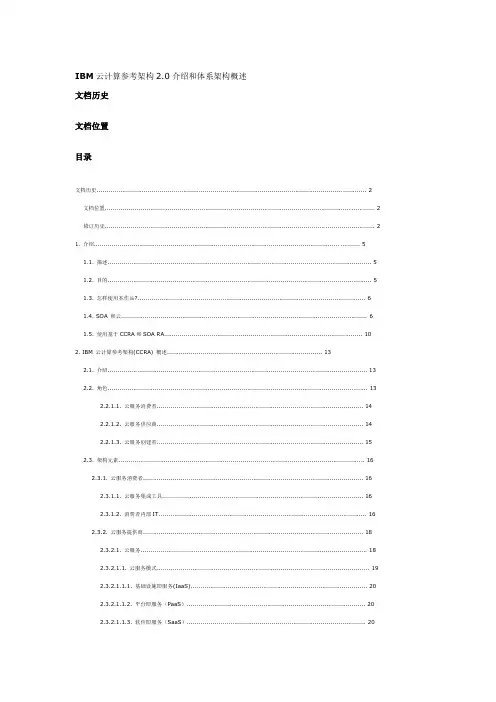
IBM云计算参考架构2.0介绍和体系架构概述文档历史文档位置目录文档历史 (2)文档位置 (2)修订历史 (2)1. 介绍 (5)1.1. 描述 (5)1.2. 目的 (5)1.3. 怎样使用本作品? (6)1.4. SOA 和云 (6)1.5. 使用基于CCRA和SOA RA (10)2. IBM 云计算参考架构(CCRA) 概述 (13)2.1. 介绍 (13)2.2. 角色 (13)2.2.1.1. 云服务消费者 (14)2.2.1.2. 云服务供应商 (14)2.2.1.3. 云服务创建者 (15)2.3. 架构元素 (16)2.3.1. 云服务消费者 (16)2.3.1.1. 云服务集成工具 (16)2.3.1.2. 消费者内部IT (16)2.3.2. 云服务提供商 (18)2.3.2.1. 云服务 (18)2.3.2.1.1. 云服务模式 (19)2.3.2.1.1.1. 基础设施即服务(IaaS) (20)2.3.2.1.1.2. 平台即服务(PaaS) (20)2.3.2.1.1.3. 软件即服务(SaaS) (20)2.3.2.1.1.4. 业务流程即服务(BPaaS) (21)2.3.2.1.2. 云服务创建&生态系统 (21)2.3.2.2. 基础设施 (22)2.3.2.3. 公共云管理平台(CCMP) (24)2.3.2.3.1. 商业支持服务(BBS) (27)2.3.2.3.2. 业务操作支持服务(OSS) (29)2.3.2.4. 安全性、灵活性、性能和消费性 (30)2.3.3. 云服务创建者 (31)2.3.3.1. 服务开发工具 (31)3. 云计算服务参考架构(CCRA):架构原则和相关指导 (33)3.1. CCRA特定架构原则 (33)3.1.1. 表示架构原则的起源 (33)3.1.2. 原则1:云规模设计 (34)3.1.3. 原则2:支持精简服务管理 (35)3.1.4. 原则3: 识别和利用共性 (37)3.1.5. 原则4: 在云服务的生命周期中,应该统一定义和管理 (38)4. 参考 (40)1. 介绍此篇文档是IBM云计算参照架构(CCRA)的定义说明。
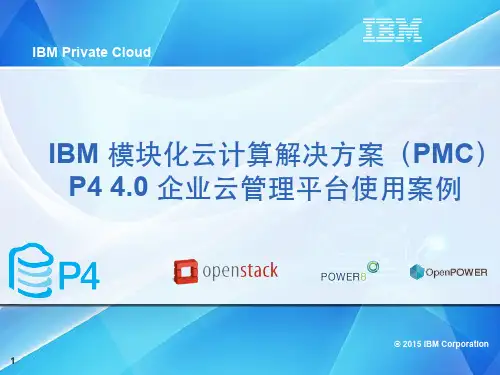
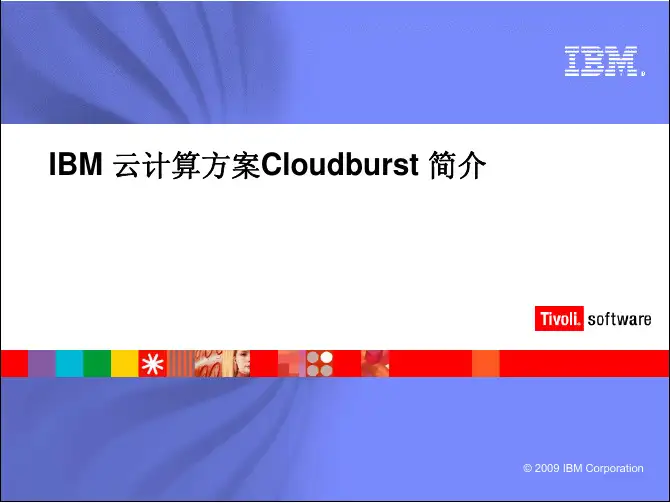
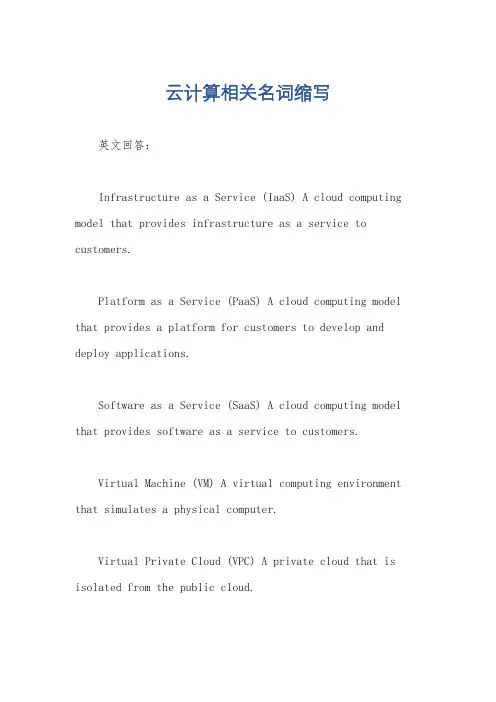
云计算相关名词缩写英文回答:Infrastructure as a Service (IaaS) A cloud computing model that provides infrastructure as a service to customers.Platform as a Service (PaaS) A cloud computing model that provides a platform for customers to develop and deploy applications.Software as a Service (SaaS) A cloud computing model that provides software as a service to customers.Virtual Machine (VM) A virtual computing environment that simulates a physical computer.Virtual Private Cloud (VPC) A private cloud that is isolated from the public cloud.Elastic Cloud Compute (ECC) A type of cloud computing that allows users to dynamically adjust the amount of computing resources they use.Hypervisor A virtualization software layer that allows multiple VMs to run on a single physical server.Container A lightweight, isolated environment for running applications.Kubernetes An open-source container orchestration system for automating the deployment, management, and scaling of containerized applications.OpenStack An open-source cloud computing platform for managing and orchestrating large-scale clouds.Cloud Management Platform (CMP) A tool for managing and monitoring cloud computing resources.Cloud Service Provider (CSP) A company that provides cloud computing services to customers.Cloud Adoption Framework A framework for adopting cloud computing technologies.Cloud Computing Reference Architecture (CCRA) A reference architecture for designing and implementing cloud computing solutions.Cloud Security Alliance (CSA) An organization that promotes the understanding and adoption of cloud security best practices.中文回答:基础设施即服务 (IaaS) 云计算模型,为客户提供基础设施即服务。
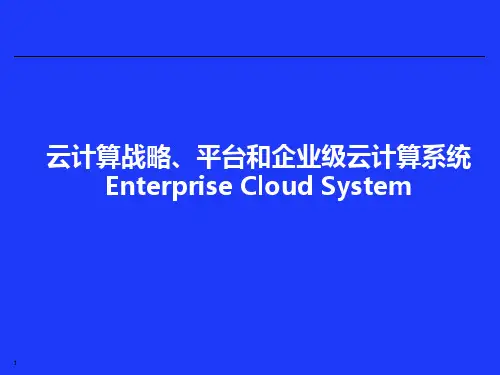

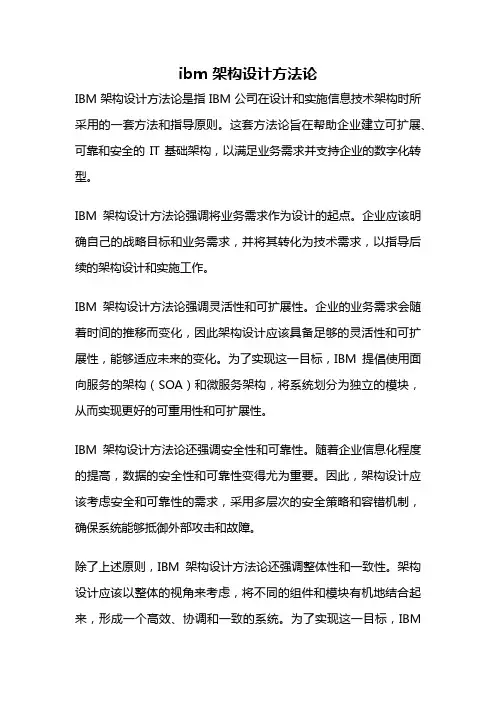
ibm 架构设计方法论IBM架构设计方法论是指IBM公司在设计和实施信息技术架构时所采用的一套方法和指导原则。
这套方法论旨在帮助企业建立可扩展、可靠和安全的IT基础架构,以满足业务需求并支持企业的数字化转型。
IBM架构设计方法论强调将业务需求作为设计的起点。
企业应该明确自己的战略目标和业务需求,并将其转化为技术需求,以指导后续的架构设计和实施工作。
IBM架构设计方法论强调灵活性和可扩展性。
企业的业务需求会随着时间的推移而变化,因此架构设计应该具备足够的灵活性和可扩展性,能够适应未来的变化。
为了实现这一目标,IBM提倡使用面向服务的架构(SOA)和微服务架构,将系统划分为独立的模块,从而实现更好的可重用性和可扩展性。
IBM架构设计方法论还强调安全性和可靠性。
随着企业信息化程度的提高,数据的安全性和可靠性变得尤为重要。
因此,架构设计应该考虑安全和可靠性的需求,采用多层次的安全策略和容错机制,确保系统能够抵御外部攻击和故障。
除了上述原则,IBM架构设计方法论还强调整体性和一致性。
架构设计应该以整体的视角来考虑,将不同的组件和模块有机地结合起来,形成一个高效、协调和一致的系统。
为了实现这一目标,IBM提倡使用统一的标准和规范,确保系统的各个组成部分之间能够无缝地协作。
在具体的架构设计过程中,IBM架构设计方法论提供了一套详细的指导原则和步骤。
首先是需求分析阶段,通过与业务部门的沟通和理解,明确业务需求和目标。
然后是架构设计阶段,根据需求分析的结果,设计出适合的系统架构,包括硬件、软件、网络和安全等方面。
接下来是实施阶段,将设计好的架构方案转化为实际的系统,并进行测试和调优。
最后是运维和优化阶段,对系统进行监控和维护,及时处理故障和性能问题。
总的来说,IBM架构设计方法论是一套综合性的指导原则和方法,可以帮助企业构建可靠、安全和高效的信息技术基础架构。
通过遵循这套方法论,企业可以更好地满足业务需求,提高业务效率,并为未来的发展奠定坚实的基础。
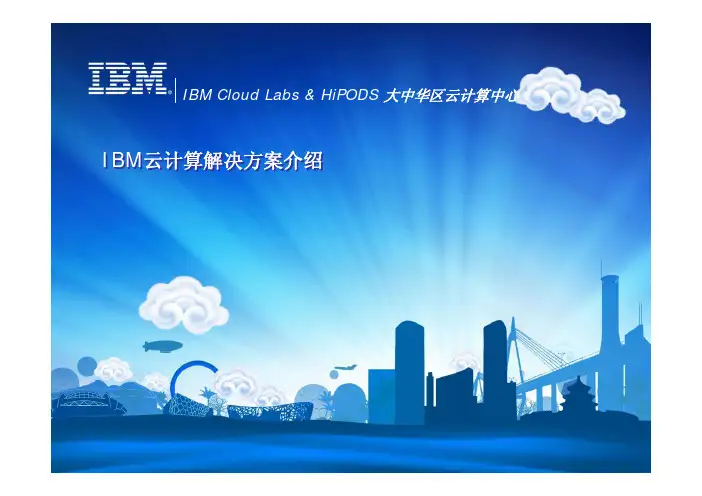
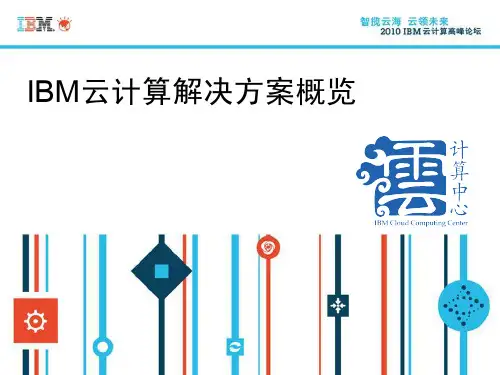
IBM IT基础架构:搭建混合云的新底座作者:路沙来源:《中国信息化周报》2021年第06期近年来, IBM系统、硬件一直在向云而生,全面转型。
2015-2018年,IBM先后推出z13、z14、LinuxONE以及“云就绪”主机z14 ZR1和LinuxONE Rockhopper Ⅱ,加密技术层层升级,以安全为核心展开云化探索。
2019年,IBM明确将IBM Z定位为安全的混合云策略的中心,又推出为云而生的新一代主机新一代z15和LinuxONEIⅡ,以多项业内首创技术保障混合云安全,并将云原生引入主机。
进入2020年,IBM收购红帽的成果相继落地,主机云化速度进一步加快,IBM Z和LinuxONE全面支持Red Hat OpenShift。
面对肆虐全球的疫情及其对经济的冲击,企业比以往任何时候都更迫切地需要提高行动速度和灵活性,并加速数字化转型计划的实施,而 IBM 的混合多云战略与 Red Hat 技术则在这场变革中发挥了核心作用。
关键技术加速迈向混合云Forrester公司最近针对“有效混合多云战略的关键”的主题进行了一次调研,结果显示:85% 的受访者正在考虑增加对公有云之外的 IT 基础架构的投资,这表明企业将继续使用本地环境和私有云,也预示着混合云是企业数字化转型过程中IT基础设施的重要选择。
2020年11月,IBM 宣布即将推出新功能帮助客户使用 IBM IT 基础架构实施混合云:通过 IBM Cloud Pak for Data 将 AI 融入整个企业并且整合数据库;IBM Cloud Pak for Data 已经可用于 IBM Power Systems, 11 月起可用于 IBM Z ;通过使用 IBM Z 上的 IBM Cloud Pak for Integration,加速数字化转型,并将云原生应用连接到现有工作负载;通过使用面向 IBM Z 和Power Systems 的 IBM Cloud Pak for Applications 支持的集成运行系统时,加快云原生应用的开发速度。
IBM建立大中华区云计算中心显示的文件列表写入一个文本文件.>xeopysource【destination]/h,d:nd—Y命令的作用是把从"卜一d—Y日期以后修改过或新建的要提取的文件拷贝到目标路径下,如果是隐藏文件和系统文件也不例外.以光盘系统启动后采集以WindowsPE光盘或LinuxLiveCD启动计算机,可在一个独立于原硬盘操作系统的新系统上挂载原硬盘分区,从而使提取样本文件不受病毒进程的影响.通过访问挂马网站采集有些网站被黑客入侵后网贞被嵌入恶意代码,使得访问它的客户端自动连接到关联的木马站点下载木马病毒,所以可以通过这种途径收集到病毒样本.蜜罐方法可以在内部网设立蜜罐被动或主动搜集病毒样本.们提交到www.virustota1.eonl供32款防病毒产品免费的检测,由它返回的检测报告分析判断是否真的含有恶意代码.如果有1/3或以上数量的防病毒产品检测出有病毒,而其他防病毒产品未检测出来就必须再提交到相应的安全厂商,让这些安全厂商确认后修正病毒定义使其产品更新后具有处理该病毒的能力.此外,要根据病毒样本的具体情况,有的需要在虚拟机环境下运行,并通过抓包观测它的网络行为,如果涉及到连接木马网站下载木马的行为,就要把它所连的网站的域名和IP揪出来,予以网络封锁.如果有ARP欺骗行为或试图通过某种网络端口进行感染传播的行为,也要有相应的防护措施和向用户告警.样本分析与联动样本归档前面步骤拿到的样本是疑似病毒样本,不一定是真正的病毒样本,病毒样本的确认需要经过分析.分析的方法有直接拆解的方法,反汇编的方法等等,但是这种方法比较费时费力.我们的做法是将它样本分析完后要及时的归档隔离,并做好相关登记工作.绝不能放到网络可达的地方,并严禁无关的人接触它们,应定期予以销毁.圆(作者单位为中山大学信息与网络中心)中山大学通过VirusTotal检测41个病毒样本.检测结果显示——主流防病毒软件检测率基本接近去年底,中山大学信息与网络中心将2007年9月~l0月发生的各种重大安全事件中提取的病毒样提交VirusTotal(www.virustotalm)进行了分析.图中为10种防病毒产品在vinTotal的首次检出率.提交给VirusTotal的病毒样本共有41个,样本的病毒类型主要集中在目前学校流行的网络游戏盗号木马,移动介质蠕虫,下载器蠕虫上.(需要提醒的是,防病毒软件的查杀率仅是评价防病毒产品的一个重要指标.)由于学校购买了SymantecAntivirusTMCorporati0n Edition,对~irusTotal中Antivirus无法检测到的样本,中山大学信息与网络中心会即时提交Symantec,Symantec会在24小时内确定是否病毒,一旦样本被确定会及时更新病毒定义.Vinb『a】是一款可疑文件分析服务,通过各种知名反病毒引擎,对用户所上传的文件进行检测,以判断文件是否被病毒,蠕虫,木马,以及各类恶意软件感染:virusTotal是由独立的rr安全实验室}kpa$isteir~s所开发的:(来自中山大学信息与网络中心)Symantec推出XPSP3注册表工具承认与微软系统冲突据消息,6月6日,Symanlec公司发布了一个小工具SymRegFix,帮助xPSP3或VislaSPI 用户清理注册表内产生的大量垃圾键值.在微软XPSP3和VislaSPI相继推出之后,Symanlec曾警告说,XPSP3和VistaSPI里有个名为"Fixccs.Pxe" 的工具,会在注册表很多地方留下无用键值,而这又会引起设备管理器,无线网络适配器等方面的问题:对于安装Norton2008软件但尚未升级XPSP3或vistaSPI的用户,Symantee表示,只需将Norton2008自动升级一次即可解决.现在.已经升级XPSP3或VislaSPI的用户,就可以下载SymRegFix,运行后即可清除注册表内的无用键值相关专家认为,这个消息的发布透露出传说中的SyIT1anlec的SAV和Wind0WSxP的SP3有冲突是事实.他表示,冲突来自于Synlan|ec用于保护软件自身不受恶意软件蠕虫等修改的模块SymProlec!,它与微软的Fixccs. exe软件在修改注册表时会发生冲突.IBM建立大中华区云计算中心本刊讯6月24日,IBM在北京IBM巾国创新中心隆重举行了以"携手云端?创新未来"为主题的IBM大中华区云计算中心启动仪式.IBM宣布建立IBM大中华区云计算中心,该中心将帮助大中华地区的客户设计和部署自己的云计算设施和程序.IBM大中华区云计算中心是第二个落户中国的云计算巾心.今年2月,IBM宣布在中国无锡太湖新城科教产业同建立第一个中国云计算中心.落户北京的新的中心将为客户提供云计算平台概念验证测试,以及设计和部署云计算基础架构和计划.该中心将为客户提供相关云计算环境的多种资源,包括案例研究和技能培训等.IBM~I|新与技术执行副总裁NickDonofrio先生表示:"云计算中心不仅能够帮助大中华地区的客户从下一代数据中心巾获益,而且能够帮助中国客户拥抱以服务为基础的全球经济和之前的电力和制造业基础架构类似,数据中心通过不断整合实现扩展,从而变得更加高效,并且实现同合作伙伴及公众互联网基础架构之间的互联.这样,一个信息技术全球价值链开始浮现出来." 2..87中国教育网络11。
以我给的标题写文档,最低1503字,要求以Markdown文本格式输出,不要带图片,标题为:ibm云计算方案# IBM云计算方案## 什么是IBM云计算IBM云计算是基于云技术的计算模型,使用虚拟化技术将计算资源、存储资源和网络资源整合在一起,为用户提供灵活、可扩展的计算服务。
IBM云计算方案是IBM提供的一套基于云平台的解决方案,旨在帮助企业实现数字化转型、提升业务创新和竞争力。
## IBM云计算的优势IBM云计算方案具有以下优势:### 1. 可靠性和高性能IBM云计算基于全球范围的数据中心和网络架构,提供高可用性和高性能的计算服务。
IBM的数据中心采用了先进的硬件设备和软件技术,保证了系统的稳定性和可靠性。
### 2. 弹性扩展和灵活性IBM云计算方案可以根据用户需求进行弹性扩展,即根据用户的计算需求动态增加或减少计算资源。
用户可以根据自己的业务需求随时调整计算资源的规模,以实现更好的资源利用和成本控制。
### 3. 安全和合规性IBM云计算方案采用了高级的安全技术和策略,包括数据加密、身份验证、访问控制等。
IBM的数据中心符合全球范围内的安全和合规性标准,可以保护用户的数据安全。
### 4. 多样化的服务IBM云计算方案提供了多样化的服务,包括计算、存储、数据库、人工智能等。
用户可以根据自己的需求选择相应的服务,以满足不同的业务需求。
## IBM云计算方案的应用场景IBM云计算方案适用于各种不同的行业和应用场景,包括但不限于以下几个方面:### 1. 企业级应用IBM云计算方案可以帮助企业将传统的企业应用迁移到云平台上,提升应用的灵活性和可扩展性。
用户可以根据自己的需求选择不同的服务,包括计算、存储、数据库等,以满足企业的业务需求。
### 2. 数据分析和人工智能IBM云计算方案提供了强大的数据分析和人工智能服务,用户可以通过云平台,将海量的数据进行分析和挖掘,以获取有价值的信息和洞察。
IBM 云计算解决方案什么是云计算?云计算是一种基于网络的计算,它提供了一种廉价、高效、可伸缩的计算资源共享方式。
在云计算中,计算资源分别在各自的服务器上分配,由用户按需使用。
随着云计算市场的不断发展,越来越多的企业已经开始将自己的应用程序转移到云端,以获得更灵活、更高效、更有竞争力的解决方案。
IBM 云计算解决方案简介IBM 云计算解决方案包括了 IBM 的云服务、软件和硬件,以及一系列相关技术和工具。
IBM 云计算可以帮助企业实现灵活、高效和安全的计算资源共享。
IBM 云计算提供了各种云服务,包括基础架构即服务、平台即服务和软件即服务。
基础架构即服务是指提供服务器、存储和网络等基础计算资源的服务。
平台即服务是指提供开发、运行和管理应用程序的平台的服务。
软件即服务是指提供各种软件应用程序和工具的服务。
IBM 云计算解决方案的优势IBM 云计算解决方案具有以下几个优势:可靠性IBM 云计算使用 IBM 的硬件、软件和技术,提供了高可靠性和高可用性的云服务。
安全性IBM 云计算支持基于标准的安全控制和访问控制,包括身份认证和数据加密等,保护了客户数据的隐私和机密性。
灵活性IBM 云计算提供了各种计算资源的选择,包括服务器、存储、网络和软件等,可以根据需求进行灵活、可伸缩的使用。
成本效益IBM 云计算提供了按需使用的计费方式,使客户只需为实际使用的计算资源付费,从而降低了成本。
IBM 云计算解决方案的使用案例以下是几个使用 IBM 云计算解决方案的案例:金融行业金融行业是一个高度安全、高度敏感的行业,需要高可靠性和高可用性的计算资源。
IBM 云计算提供了安全、灵活的云服务,可以帮助金融机构实现信用卡处理、交易结算等业务。
电信行业电信行业需要处理大量的数据和交易,需要高度可靠性和可扩展性的计算资源。
IBM 云计算提供了可靠的云服务,支持大数据处理和快速扩容等业务。
制造业制造业需要在不同地点共享计算资源,需要安全可靠的云服务。
1. 概述IBM’S系统是一种先进的信息管理系统,旨在提高企业的效率和生产力。
本文档将介绍IBM’S系统的架构、功能以及实施步骤。
2. 架构IBM’S系统采用三层架构,包括前端展示层、应用逻辑层和数据存储层。
2.1 前端展示层前端展示层是用户与系统交互的界面,旨在提供友好的用户体验。
IBM’S系统提供了基于Web的前端界面,可跨平台使用,并支持多种浏览器。
用户可以通过前端界面访问系统的各种功能和数据。
2.2 应用逻辑层应用逻辑层是IBM’S系统的核心,负责处理用户的请求,并执行相应的业务逻辑。
该层包含多个子模块,每个子模块负责特定的功能模块,如用户管理、订单管理等。
应用逻辑层还负责与数据存储层进行交互,读取和更新数据。
2.3 数据存储层数据存储层是IBM’S系统中存储数据的地方。
系统使用关系型数据库管理系统(RDBMS)来存储和管理数据。
每个功能模块都有相应的数据表,用于存储相关的数据。
数据存储层还提供了数据访问接口,供应用逻辑层使用。
3. 功能IBM’S系统提供了多种功能,旨在满足企业的各种需求。
3.1 用户管理IBM’S系统可以管理企业的用户信息,包括用户的登录名、密码、角色等。
系统管理员可以创建、编辑和删除用户账号,并分配相应的权限。
用户可以通过登录界面进行身份验证,并使用系统的其他功能。
3.2 订单管理IBM’S系统提供了订单管理功能,用于处理企业的订单。
用户可以创建新的订单、编辑已有订单以及查询订单的状态。
系统还支持订单的审批流程,以确保订单的准确性和完整性。
3.3 产品管理IBM’S系统允许企业管理其产品信息。
用户可以添加、编辑和删除产品,并设置产品的价格、库存等属性。
系统还提供了产品搜索功能,用户可以根据关键字或其他属性查询产品。
3.4 报表生成IBM’S系统可以根据企业的数据生成各种报表。
用户可以选择不同的报表类型和参数,系统会根据用户的选择生成相应的报表。
报表可以导出为多种格式,如Excel、PDF等。
Introduction and Architecture Overview IBM Cloud Computing Reference Architecture 2.0Authors:Michael BehrendtBernard GlasnerPetra KoppRobert DieckmannGerd BreiterStefan PappeHeather KregerAli ArsanjaniDocument HistoryDocument LocationThis is a snapshot of an on-line document. Paper copies are valid only on the day they are printed. Refer to the author if you are in any doubt about the currency of this document.Revision HistoryDate of this revision: 02-28-11 Date of next revision: to be definedRevision Number RevisionDateSummary of Changes Changesmarked1.0 02-28-11 1.0 Submission to Open Group NContentsDocument History (2)Document Location (2)Revision History (2)1.Introduction (5)1.1.Description (5)1.2.Purpose (5)1.3.How to use this work product? (6)1.4.SOA and Cloud (6)ing the SOA RA with the CCRA (8)2.IBM Cloud Computing Reference Architecture (CC RA) Overview (11)2.1.Introduction (11)2.2.Roles (12)2.2.1.1.Cloud Service Consumer (12)2.2.1.2.Cloud Service Provider (12)2.2.1.3.Cloud Service Creator (12)2.3.Architectural Elements (13)2.3.1.Cloud Service Consumer (13)2.3.1.1.Cloud Service Integration Tools (13)2.3.1.2.Consumer In-house IT (14)2.3.2.Cloud Service Provider (15)2.3.2.1.Cloud Services (15)2.3.2.1.1.Cloud service models (16)2.3.2.1.1.1.Infrastructure-as-a-Service (17)2.3.2.1.1.2.Platform-as-a-Service (17)2.3.2.1.1.3.Software-as-a-Service (17)2.3.2.1.1.4.Business-Process-as-a-Service (17)2.3.2.1.2.Cloud service creation & ecosystem aspects (17)2.3.2.2.Infrastructure (19)mon Cloud Management Platform (CCMP) (21)2.3.2.3.1.BSS – Business Support Services (24)2.3.2.3.2.OSS – Operational Support Services (26)2.3.2.4.Security, Resiliency, Performance & Consumability (27)2.3.3.Cloud Service Creator (28)2.3.3.1.Service Development Tools (28) Reference Architecture: Architectural Principles and Related Guidance (29) RA-Specific Architectural Principles (29)3.1.1.Origins of the Term Architectural Principle (29)3.1.2.Principle 1: Design for Cloud-Scale Efficiencies (30)3.1.3.Principle 2: Support Lean Service Management (31)3.1.4.Principle 3: Identify and Leverage Commonalities (33)3.1.5.Principle 4: Define and Manage Cloud Services generically along their Lifecycle (34)4.References (36)1. IntroductionThis document serves as the definition of the IBM Cloud Computing Reference Architecture (CC RA).A Reference Architecture (RA) provides a blueprint of a to-be-model with a well-defined scope, requirements it satisfies, and architectural decisions it realizes. By delivering best practices in a standardized, methodical way, an RA ensures consistency and quality across development and delivery projects.The mission of the CC RA is defined as follows:Definition of a single Cloud Computing Reference Architecture, enabling cloud-scale economics in delivering cloud services while optimizing resource and labor utilization and delivering a design blueprint for ▪Cloud services, which are offered to customers▪Private, public or hybrid cloud projects▪Workload-optimized systems▪Enabling the management of multiple cloud services (across I/P/S/BPaaS) based on the same, common management platform for enabling economies of scale.1.1. DescriptionThe CC RA is based on real-world input from many cloud implementations across IBM. TheArchitecture Overview Diagram (AOD) provides overview of the fundamental architectural building blocks making up the CC RA. It also defines architectural principles serving as a guideline forcreating any cloud environment.1.2. PurposeThe Cloud Computing Reference Architecture is intended to be used as a blueprint / guide for architecting cloud implementations, driven by functional and non-functional requirements of the respective cloud implementation. Consequently, the CC RA should not be viewed as fine-granular deployment specification of just a single specific cloud implementation (and its management platformThis document serves the following purposes:1. This document defines the basic architectural elements and relationships which make up the IBMCloud Computing Reference Architecture.2. This document defines the basic architectural principles which are fundamental for delivering &managing cloud services.The audience of the CC Reference Architecture is:∙Development teams implementing cloud services exploiting CCMP capabilities∙Development teams implementing the CCMP delivery & management capabilities for cloud servicesPractitioners implementing private clouds for customers1.3. How to use this work product?The architecture overview is intended to provide a common, coherent architectural structure which should be used as a basis for any cloud computing project. This allows representing the architecture of any cloud project in a consistent fashion. Existing “legacy” products and tech nologies as well as new cloud technologies can be mapped on the AOD to show integration points amongst the new cloud technologies and integration points between the cloud technologies and already existing ones.The architectural principles define the fundamental principles which need to be followed when realizing a cloud. These principles need to be followed on all implementation stages (architecture, design, and implementation) and have implications across all work products.1.4. SOA and CloudIn order to understand the IBM CCRA it is important to understand the relationship between SOA and Cloud, not only at an architectural level, but also at a solution and service level.Service oriented architecture (SOA) is defined by The Open Group(/soa/soa/def.htm) to be “an architectural style that supports service orientation. Service orientation is a way of thinking in terms of services and service-based development and the outcomes of services.”According to NIST (/groups/SNS/cloud-computing/cloud-def-v15.doc), “Cloud Computing is a model for enabling ubiquitous, convenient, on-demand network access to a shared pool of configurable computing resources (e.g., networks, servers, storage, applications, and services) that can be rapidly provisioned and released with minimal management effort or service provider interaction. This cloud model promotes availability and is composed of five essential characteristics, three service models, and four deployment models.”The Service models are Cloud Infrastructure as a Service, Cloud Platform as a Service, and Cloud Software as a Service. The service models, and the fact that cloud computing is discussed in terms of the creation, delivery and consumption of cloud services, means cloud computing supports service orientation. Enterprises expose infrastructure, platforms and software as services as part of SOA solutions today. Certainly Software as a Service is not new and has been a popular topic for years.The cloud Deployment models are Private, Community, Public, and Hybrid. These deployment models define the scope of the cloud architecture and solution, does the cloud solution exist strictly within the organization boundaries (private), across organization boundaries (public), or a combination (Hybrid). Certainly these scopes have been seen in SOA solutions before Cloud (while there was not a well known architectural model for them as there is in cloud computing), there are SOA solutions that exist strictly within an enterprise, or between businesses across enterprise boundaries (B2B). In fact one of the key values of SOA was to develop SOA solutions with services that are integrate between business partners, enabling outsourcing, simplifying integration and increasing agility, much like the Hybrid model. Cloud computing enables this paradigm by adding cloud-characteristics to the services being delivered & consumed.The essential characteristics for Cloud Computing are on-demand self-service, broad network access, resource pooling, rapid elasticity, and measured Service. These characteristics can be found inrequirements and SOA solutions in various organizations today, although these characteristics are optional for SOA and mandatory for cloud.Usually, a single SOA solution does not have all of these are characteristics simultaneously, unless it is a very mature organization leveraging SOA. For these organizations, each of these solutions had to be built in its entirety for that organization. The SOA solution and management of it must be built from scratch, and is not generally shared amongst organizations. Reuse is generally within an organization or an industry, not between organizations and entire communities. Service delivery and consumption aspects are a small part of the requirements for the SOA solution.What is new about cloud is that instead of supporting these requirements per solution, the industry is trying to …standardize‟ how these requirements are being met to enable cloud computing. Cloud architectures require a set of capabilities and ABBs to meet the NIST essential characteristics that are optional in SOA. In addition, these ABBs may be implemented in Cloud specific ways to handle scale, cost optimization and automation.This discussion shows that Cloud computing architectures are Service Oriented architectures and adhere to architectural style that supports service orientation. Cloud solutions are SOA solutions.The Open Group defines a service:“ A service:∙Is a logical representation of a repeatable business activity that has a specified outcome (e.g., check customer credit; provide weather data, consolidate drilling reports)∙Is self-contained∙May be composed of other services∙Is a “black box” to consumers of the service “Cloud services, according to The Open Group definition, are SOA services. However, not all SOA services are Cloud service because they require automated deployment and management as well as offering support in order to support the Cloud characteristics.On the architecture continuum (see TOGAF at/architecture/togaf9-doc/arch/chap39.html), Cloud architectures are more concrete than The Open Group‟s SOA reference architecture(/projects/soa-ref-arch/uploads/40/19713/soa-ra-public-050609.pdf), a domain architecture scoped to service delivery and management. Principles and architectural decisions have been premade already to enable the Cloud computing architecture to be self service, network accessible, and scalable. Architectural building blocks have already been identified for Cloud solution architects to use for operational and business support. In some cases, Cloud service providers may provide well defined, maybe even standardized, management and security support and services.For cloud, some service identification has been done (reusable, utility services, for example, to control VMs and deploy/undeploy applications or services) and implementations of services may be available from an existing services ecosystem. The existence of this services ecosystem and concrete architecture makes SOA via cloud simpler for service consumers to adopt because the designs and implementations have been provided.The benefit of recognizing the heritage of Cloud from SOA is that the existing experience over the last 5 years and standards already available for SOA and SOA solutions can be applied to Cloud Computing and Cloud solutions.SOA standards in The Open Group that can be applied to Cloud include:∙The Open Service Integration Maturity Model – this model helps determine the level of service use in an organization, these levels apply to the use of cloud services. Cloud computing can be seen as the …Virtualized” and “Dynamically reconfigurable” levels.∙The SOA Ontology defines service and SOA concepts which can be used as a basis for describing cloud services, though extension Ontologies should be developed for cloud..∙The SOA Reference Architecture defines the functional and cross cutting concerns and ABBs for SOA, which also applies to Cloud. This standard has been used as a basis for the IBM CCRA.∙The SOA Governance Framework defines a governance reference model and method that applies to the development of cloud services and solution portfolio and lifecycle management. Bestpractices for governance of Cloud solutions will need to be developed in addition to this standard.∙Security for Cloud and SOA, a joint workgroup between SOA and Cloud Workgroups in The Open Group, defines security considerations and ABBs for both Cloud and SOA.∙SOCCI, another joint SOA and Cloud Workgroup in The Open Group defines the architecture for exposing infrastructure as a service for both SOA and Cloud solutions.Certainly functions that were optional for SOA solutions are now required for Cloud solutions, like virtualization, security across business boundaries, and service management automation. New functions and requirements are getting in focus with cloud driving experiences from the SOA world to the next level.1.5. Using the SOA RA with the CCRAThe SOA RA(/projects/soa-ref-arch/uploads/40/19713/soa-ra-public-050609.pdf),), as being standardized by The Open Group, applies to Cloud architectures and is the underlying architecture for the IBM CCRA.The functional concerns: operational systems, service components, services, business processes and consumer interfaces; all exist in and are relevant to functional concerns for cloud architecture‟sFor the Cloud architecture, there has been special focus on the:∙Operational Layer: Infrastructure is part of the operational systems layer, but often highlighted in Cloud architectures because Cloud imposes new requirements on infrastructure to enable broad network access, resource pooling, rapid elasticity, virtualization and scalability.∙Service Layer: The common cloud service types, *aaS, are identified in the services layer. These cloud service types, like other services, use and sometimes expose assets in the Operationalsystems layer. For cloud services, which assets are exposed is often the focus of the service type, ie within operational systems, hardware infrastructure is exposed as IaaS, and middleware isexposed as PaaS, and business process as BPaaS.∙Business Process: Business processes participate in a Cloud solution much like they do in SOA solutions, they can be provided as a service (BPaaS) or be the consumer of services (whether they care cloud services or not). Additionally, business processes within a cloud provider organization need to be restructured and streamlined in novel ways to meet much faster time-to-deliver,time-to-change and cost objectives..∙Consumer Layer: The consumer layer is more strictly and carefully separated from the services and service provider to allow pooling and substitution of cloud services or providers.The cross cutting concerns in the SOA RA: integration, quality of service, information and governance: are important concerns for all cloud architectures and solutions, just like they are for SOA. The fact that they are cross cutting means that each of the functional layers may have interactions with capabilities in the cross cutting layers.For the Cloud architecture, there has been special focus on the:∙Quality of Service (QOS) layer: The Quality of Service cross cutting concern has additional significant requirements for Cloud for management and security in order enable NISTs on-demand self-service and measured service requirements as well as IBM‟s requirements for resiliency,security, performance, automated management, operational, and business support. Themanagement support can be represented as a Common Cloud Management Platform in the SOA RA QOS layer, which includes support for operational and business support services, aka OSS and BSS. This is critical for driving economies-of-scale by delivering many cloud services based on the same foundation.∙Governance for cloud solutions will also have some unique patterns of requirements needed to support governance across organizational boundaries.For the cloud ecosystem, they cloud service consumers, providers and creators are the common high level roles identified in the cloud architectures.It is important to look at Cloud in the context of SOA, and Cloud solutions in the context of the larger SOA solutions underpinning them. This diagram shows the QOS layer details that are essential to understand forCloud, as well as the *aaS and Infrastructure layersThe cross cutting concerns for integration and information are still important and must be considered in the development of any Cloud architecture and solution architecture. However, cloud does not introduce any new principles or concerns to these cross cutting layers.To make it easier to focus on the Cloud concerns rather than the SOA concerns, we can lift the Cloud concerns into its own diagram, as we show in the remainder of this document.The concepts and architectural elements not depicted in the CCRA are still implied and present via its SOA RA heritage.The cross cutting concerns for integration and information are still important and must be considered in the development of any Cloud architecture and solution architecture. However, cloud does not introduce any new principles or concerns to these cross cutting layers.To make it easier to focus on the Cloud concerns rather than the SOA concerns, we can lift the Cloudconcerns into its own diagram, as we show in the remainder of this document.2. IBM Cloud Computing Reference Architecture (CC RA) Overview2.1.IntroductionThe IBM Cloud Computing Reference Architecture (CC RA, see figure 2) defines the fundamentalarchitectural elements constituting a cloud computing environment. The CC RA is structured in a modular fashion in a sense that on its highest level of abstraction, the main roles and the corresponding architectural elements are defined allowing to drill down for each of these elements as needed. Later sections of this document will describe detailed versions of this IBM Cloud Computing Reference Architecture Overview diagram, which provide a more fine-grain view of the high-level architectural elements of the overall CC RA. As a result of specifying the CC RA, a base terminology is established, which should be used as a reference for any other cloud computing related effort.The following sections will describe each architectural element of the CC RA depicted in figure 3 in detail.GovernanceSecurity, Resiliency, Performance & ConsumabilityCloud Service CreatorCloud Service ConsumerCloud Service ProviderCommon CloudManagement Platform (CCMP)Operational Support Services (OSS)Cloud ServicesInfrastructure-as-a-ServicePlatform-as-a-ServiceSoftware-as-a-ServiceBusiness-Process-as-a-ServiceBusiness Support Services (BSS)Cloud Service Integration ToolsConsumer In-house ITService Creation ToolsInfrastructureExisting & 3rd party services, Partner EcosystemsFigure 1: IBM Cloud Computing Reference Architecture Overview2.2. RolesThe IBM Cloud Computing Reference Architecture defines three main roles: Cloud Service Consumer, Cloud Service Provider and Cloud Service Creator. Each role can be fulfilled by a single person or can be fulfilled by a group of people or an organization. The roles defined here intend to capture the common set of roles typically encountered in any cloud computing environment. Therefore it is important to note that depending on a particular cloud computing scenario or specific cloud implementation, there may be project-specific sub-roles defined.2.2.1.1. Cloud Service ConsumerA cloud service consumer is an organization, a human being or an IT system that consumes (i.e., requests, uses and manages, e.g. changes quotas for users, changes CPU capacity assigned to a VM, increases maximum number of seats for a web conferencing cloud service) service instances delivered by a particular cloud service. The service consumer may be billed for all (or a subset of) its interactions with cloud service and the provisioned service instance(s).A service consumer can also be viewed as a kind of super-role representing the party consuming services. For example, in case a credit card company is using some cloud services, the company as a whole is a service consumer relative to the provider. Within the service consumer role more specific roles may exist, such as a technical role responsible for making service consumption work from a technical perspective; and there might be a business person on the consumer side who is responsible for the financial aspects. Of course, in more simplified public cloud scenarios all of these consumer-centric roles could be collapsed into a single person, but the roles still exist.The cloud service consumer browses the service offering catalog and triggers service instantiation and management from there. There may be cases where the interaction with the service delivery catalog is tightly embedded within the actual cloud service. In particular this is pretty common for SaaS and BPaaS cloud services where application-level virtualization is implemented, e.g. LotusLive.2.2.1.2. Cloud Service ProviderThe Cloud Service Provider has the responsibility of providing cloud services to Cloud Service Consumers.A cloud service provider is defined by the ownership of a common cloud management platform (CCMP). This ownership can either be realized by truly running a CCMP by himself or consuming one as a service. People acting in the role of a Cloud Service Provider and a Cloud Service Consumer at the same time would be a partner of another cloud service provider reselling cloud services or consuming cloud services and adding value add functionality on top, which would in turn be provided as a cloud service.Although defined as a separate role, it would also be possible that a Cloud Service Provider has Cloud Service Creators in the same organization, i.e. it is not necessary that Cloud Service Provider and Cloud Service Creator are in separate organizations.2.2.1.3. Cloud Service CreatorThe Cloud Service Creator is responsible for creating a cloud service, which can be run by a Cloud Service Provider and by that exposed to Cloud Service Consumers. Typically, Cloud Service Creators build their cloud services by leveraging functionality which is exposed by a Cloud Service Provider. Management functionality which is commonly needed by Cloud Service Creators is defined by the CCMP architecture. A Cloud Service Creator designs, implements and maintains runtime and management artifacts specific to a cloud service.Just like the Cloud Service Consumer and the Cloud Service Provider, the Cloud Service Creator can be an organization or a human being. For example, an ISV company developing a cloud service is a CloudService Creator , whereas obviously there could be 100‟s of employees within that particular Cloud Service Creator incarnation, each of them taking on a specific business or technically focused sub-role.It is also typical that that operations staff responsible for operating a cloud service is closely integrated with the development organization developing the service (this integration is commonly referred to as “DevOps”). This is an important aspect to achieve the delivery efficiency expected from cloud services as it allows a very short feedback loop to implement changes in the cloud service which benefit the operational efficiency of the cloud service.2.3. Architectural Elements 2.3.1. C loud Service ConsumerGovernanceSecurity, Resiliency, Performance & GovernanceCloud Service CreatorCloud ServiceConsumerCloud Service ProviderCommon CloudManagement Platform (CCMP)Operational Support Services (OSS)Cloud ServicesInfrastructure-as-a-ServicePlatform-as-a-ServiceSoftware-as-a-ServiceBusiness-Process-as-a-ServiceBusiness Support Services (BSS)Service Creation ToolsInfrastructureExisting & 3rd party services, Partner EcosystemsCloud Service Integration ToolsConsumer In-house ITInfrastructureMiddleware Applications Business Processes Consumer AdministratorConsumer Business ManagerConsumer End userService IntegratorService ManagementFigure 2: IBM CC RA – Cloud Service Integration Tools & Consumer In-house IT2.3.1.1. Cloud Service Integration ToolsFrom the perspective of a Cloud Service Consumer, it is important to be able to integrate cloud services with their on-premise IT. The functionality of Cloud Service Integration Tools is specifically relevant in the context of hybrid clouds, where seamless integrated management, usage and interoperability of cloud services in integration with on-premise IT is critical.2.3.1.2. Consumer In-house ITBesides IT capabilities consumed as cloud services, consumers of such IT may continue to have in-house IT, which can be managed in a traditional non-cloud fashion. In case functionality of the existing in-house IT should be integrated with cloud services consumed from a cloud service provider, the aforementioned cloud service integration tools are required. Consumer in-house IT exists across all layers of the technology stack (infrastructure, middleware, applications, business processes, service management), therefore integration with cloud services can take place on each of these layers.2.3.2. C loud Service Provider2.3.2.1. Cloud ServicesGovernanceSecurity, Resiliency, Performance & ConsumabilityCloud Service CreatorCloud ServiceConsumerCloud Service ProviderCommon CloudManagement Platform (CCMP)Operational Support Services (OSS)Cloud ServicesInfrastructure-as-a-ServicePlatform-as-a-ServiceSoftware-as-a-ServiceBusiness-Process-as-a-ServiceBusiness Support Services (BSS)Cloud Service Integration ToolsConsumer In-house ITService Creation ToolsInfrastructureExisting & 3rd party services, Partner EcosystemsI n f r a s t r u c t u r e M g m t I n t e r f a c e sP l a t f o r m M g m t I n t e r f a c e sS o f t w a r e M g m t I n t e r f a c e s B P M g m t I n t e r f a c e sAPIAPIAPIAPIFigure 3: IBM CC RA – Cloud Service DetailsCloud Services can represent any type of (IT) capability which is provided by the Cloud Service Provider to Cloud Service Consumers, implementing all cloud characteristics (self-service access, network-based access, served out of a resource pool, elastic, pay-per-use). There are four categories of Cloud Services: Infrastructure, Platform, Software or Business Process Services. In contrast to traditional (IT) services, cloud services have attributes associated with cloud computing, such as a pay-per-use model, self-service usage, flexible scaling & shared of underlying IT resources.The management functions defined as part of the CCMP architecture are responsible for deliveringinstances of Cloud Services of any category to Cloud Service Consumers, the ongoing management of all Cloud service instances from a provider perspective and allowing Cloud Service Consumers to manage their Cloud Service instances in a self-service fashion.For all cloud services there is software required implementing cloud service specifics: For IaaS, there are typically hypervisors installed on the managed hardware infrastructure, for PaaS there would amulti-tenancy enabled middleware platform, for SaaS a (multi-tenancy enabled) end-user application and for BPaaS there typically is a multi-tenancy enabled business process engine.Depending on the nature of the respective cloud service, there are cloud service specific management interfaces exposed, which are typically used by the management services as defined in the CCMP architecture.Each cloud service also typically exposes APIs towards the cloud service consumer for programmatic use. Cloud Services can be built on top of each other, e.g. a software service could consume a platform or infrastructure service as its basis, a platform service could consume an infrastructure service as its foundation. However, this is not required, i.e. a software service could also directly be built on top of bare metal infrastructure, clearly inheriting all constraints associated with such an infrastructure. In general, architectural principle #3 postulates to share as much as possible across cloud services with respect to management platform and underlying infrastructure. However, it does not require just one single, fully homogeneous infrastructure – of course, this would be the ideal goal, but given different infrastructure requirements this is not always possible. For example, if a particular cloud service has very specific infrastructure needs (with respect to reliability, latency, throughput, computational performance, hardware platform, etc.) it is clearly allowed to run this cloud service on a dedicated infrastructure (e.g. HPC cloud services would generally run on a purpose-built physical infrastructure for performance and efficiency reasons, they wouldn‟t run on virtualized compute cloud service).In the context of building cloud services on top of each other, it is important to distinguish the sharing of a common OSS/BSS (aka CCMP) structure across multiple cloud services and the usage of the actual cloud service capability by another one. An example for the first aspect would be LotusLive and Compute Cloud exploiting / getting managed by the same OSS/BSS construct. An example for the latter aspect would be LotusLive (SaaS) using the compute capacity of a compute cloud service (IaaS) vs. purchasing their own servers.In any case, each Cloud Service offered by a Cloud Service Provider is “known” to the BSS & OSS of the Common Cloud Management Platform (otherwise the cloud service wouldn‟t be visible via the servic e catalog and ready to be consumed). A cloud service provider offers cloud services as a result of very conscious business decisions, since taking a cloud service to market must be supported by a corresponding solid business model and investments for the development and operations (software & operations staff) of the cloud service.2.3.2.1.1. Cloud service modelsThere are four cloud service models within the context of the IBM Cloud Computing Reference Architecture – Infrastructure-, Platform, Software- and Business-Process-as-a-Service.IaaS, PaaS and SaaS are defined according to the “NIST Definition of Cloud Computing” [7]. There is an IBM-specific definition of BPaaS since that is not defined by the NIST.Since this is often a point of confusion it is important to note that across all cloud service models the definition is determined by the management scope covered by the provider.For example, in IaaS “t he consumer does not manage or control the underlying cloud infrastructure […]”, in PaaS “the consumer does not manage or control the underlying cloud infrastructure, network, servers, operating systems, or storage […]”, etc.. So this essentially about the tasks the operations staff of the provider takes on, it is not about the virtualiz ation technology being used. For example, it‟s possible to use hypervisor-level virtualization to realize PaaS, SaaS or BPaaS.。